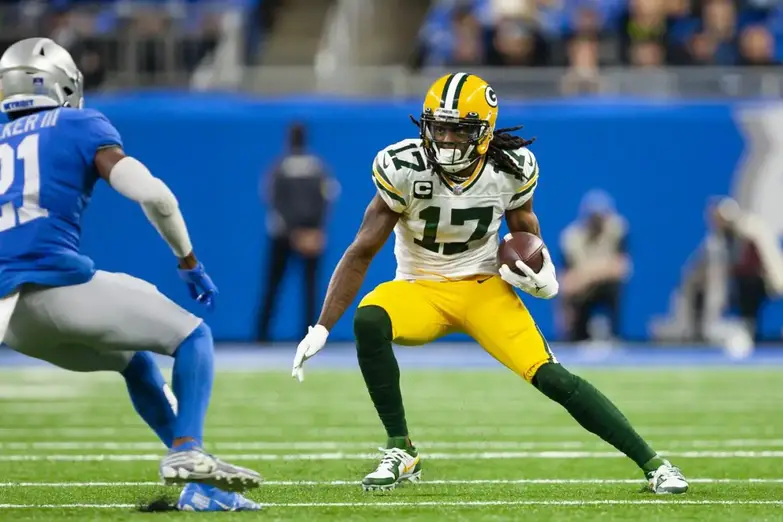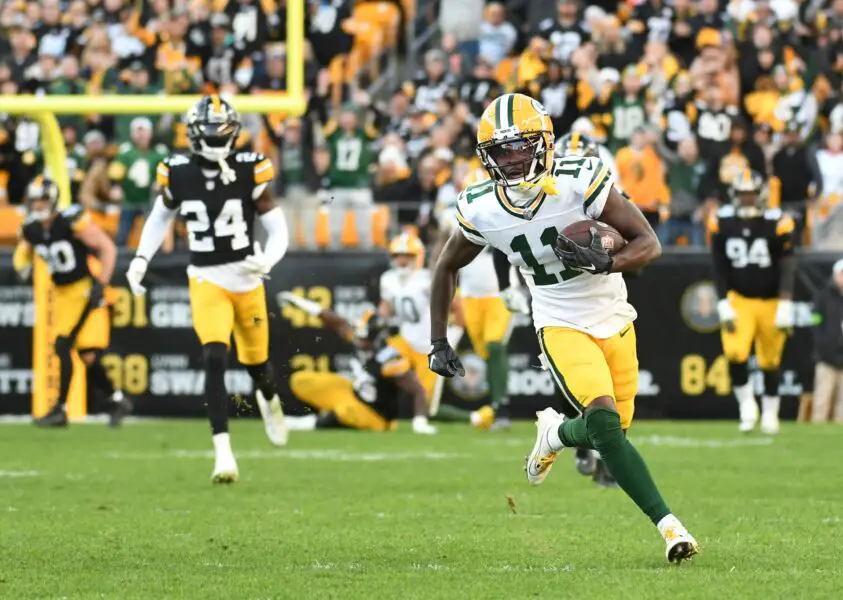Following are three observations from the first half of the schedule, including a take on one of their most disappointing players, second-year receiver Christian Watson.
It seems like a lot of people have forgotten the lessons of Jordy Nelson and Davante Adams.
They are among the three best Packers receivers of this century (Greg Jennings is the other).
But before Nelson and Adams became Pro Bowlers and All-Pros, they had their share of poor and nondescript play in the first two or three years of their NFL careers.

Adams, in fact, looked like a bust after two years in the league. His second season was marred by chronic drops and subpar production: he caught only 54% of his targets (50 of 94), scored only one touchdown, and averaged only 9.7 yards per catch.
Nelson was an afterthought his first two years in the NFL (55 receptions his first two years combined) and didn’t top the 50-catch mark for a season until his fourth season.
Yet, after thoroughly unpromising early years, they went on to become stars.
Now we have Christian Watson, a second-year pro who, like those two, was a second-round draft pick.
Watson made a much better first impression than Adams and Nelson as rookies when he revived the Packers offense with his big-play ability (eight touchdowns) in the second half of last season. Heading into 2023, he looked like he was already on the way to becoming a star.
Instead, he’s been one of the Packers’ biggest disappointments of the season, missing time in camp and early games with injuries, then not being much of a playmaker in the six games he’s played (14 catches, one touchdown, 16.9-yard average).
His shortcomings on 50-50 balls have been glaring, and he’s caught only 42.4% of his targets (14 of 33).
If social media and internet chats with fans accurately reflect the public’s mood, a lot of Packers followers have already thrown Watson in the bust bin.
It’s as though the early years in Adams’ and Nelson’s careers have been erased from public consciousness.
None of us knows how Watson will turn out a year, two, or three down the line. He’s obviously more raw than it appeared down the stretch last season when he had a decorated veteran quarterback (Aaron Rodgers) throw him the ball.
It turns out the scouts who saw Watson as very much a developmental prospect coming out of the lowest tier of Division I college football (North Dakota State of the FCS division) were right.
But to write him off halfway through his second season, especially after the way he lifted the Packers offense as a rookie, is to have amnesia about recent Packers history at that position. The bet here is that Watson will still become a very good player in this league unless the durability issues of his first two seasons do him in.
Besides his rare combination of size (6-foot-4⅛, 208 pounds) and long speed (4.36-second 40), Watson also has the quick acceleration of a smaller player. His 1.46-second 10-yard split ranks in the 97th percentile of all receivers at the NFL scouting combine since 1999, according to MockDraftable.
He’s smart (a reported 38 on the Wonderlic), by all appearances wants to be good, and has shown no signs of prima donna behavior.
Indeed, playing receiver involves much more than just being large and quick. Playing that position also requires a lot of instincts, route running, catching, and awareness.
There are many grounds to question if Watson’s 1-for-6 season on 50-50 balls this season is more the result of an inborn body control problem or if it can be greatly improved with game reps, practice, and physical development.
It appears that some onlookers believe Watson to be just a little bit quicker than Marquez Valdes-Scantling. However, it’s safe to assume that he is far more gifted and skilled than that.
In his debut season, Valdes-Scantling could not have scored that many touchdowns. His career high, in actuality, is just six.
In addition to failing Love on at least two deep passes this season when the quarterback missed him for scores, Watson has also failed Love on 50-50 throws this season.
At least some perceptions from this year would have been altered had you hit one or both of those.
In addition, Watson’s success as a rookie was largely attributed to the Packers’ inability to figure out how to get the ball to him in space and while he’s moving, such as on slants, crossing routes, and end-arounds.
Compared to last year, he has encountered more two-deep zone coverage, and the Packers haven’t run the ball effectively enough to draw opponents away from the two-deep look.
Offensive coordinator Adam Stenavich stated, “Those opportunities will present themselves as we keep going.
Those single-high coverages ought to help us out there with the crossing routes, particularly if we continue to run the ball effectively.
Not many talented NFL receivers are born into the league. There is a Davante Adams or Jordy Nelson for every Justin Jefferson or even Greg Jennings (12 touchdowns in his second season).
Anyone who is prepared to relegate Watson to the bench or trash heap would do well to keep that in mind.
Growing pains illustrated in Jordan Love pass to Luke Musgrave
The Packers’ loss to Pittsburgh last week contained a play that perfectly captured the growing pains that have characterized the first half of the team’s season.
The Packers had a chance to grab the lead early in the third quarter when they found themselves in the red zone. Rookie tight end Luke Musgrave ran a post route against zone coverage on a third-and-9 play at the Steelers 13, with Steelers safety Elijah Riley covering him on his inside shoulder.
Love would not have been open if he had tried to guide Musgrave to the back of the end zone because Riley would have had leverage on that side. However, Love threw it there after spotting a passing path to Musgrave’s back shoulder.
However, Musgrave persisted in bending his path toward the middle of the field, and the throw passed through the end zone unharmed and seemingly off target when it was well behind him.
But if Musgrave had been looking for the back-shoulder throw based on the coverage, he probably would have scored a touchdown that would have put the Packers up 20-17.
The issue was that, despite running the play numerous times on the practice field, Love and Musgrave had not done so against that coverage.
“Just one of those looks we haven’t practiced, haven’t got reps doing, Love said, so he wasn’t on the same page as me on what I was thinking.
It is one of those things that, having seen it now, allows us to move forward with growth. If we get that look again, I’m sure we’ll capitalize.
It’s not like rookie quarterbacks and pass catchers are the only ones who experience this kind of stuff.
Even after playing together for a number of years, receivers and quarterbacks occasionally misjudge one another.
With them, though, it happens much less frequently, and a play like that can alter the course of a game. In a game they lost by four points, the Packers ended that possession with a field goal as opposed to a touchdown.
Luke Musgrave’s stumbling start
A little-known mystery of the Packers’ season thus far has been Musgrave’s tendency to trip and fall after collecting deep passes.
This season, Musgrave has been open on several downfield throws, but he has lost his feet and fallen to the ground after turning to make the catch. It occurred once more last week during a third-quarter 36-yard pass down the middle seam against the Steelers.
It’s unclear if the problem is with balance or anything else while judging the ball in the air.
Musgrave tested well for his position as an athlete, though, with a 4.61 40 (the 88th percentile of tight ends at the combine since 1999), a 36-inch vertical jump (the 82nd percentile), and a 10-5 broad jump (93rd percentile).







